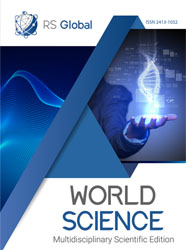STUDY OF SORPTION PROPERTIES OF VARIOUS MATERIALS FOR COLLECTING OF OIL AND OIL PRODUCTS
Abstract
The properties of natural organic, synthetic organic and inorganic materials used for picking-up oil spillages, such as oil absorption, water uptake and squeezing degree, were studied. The main methods of water purification from oil and oil products, the main types of oil sorbents, their advantages and disadvantages were considered.
References
Ananieva T.A., Volkov F.V. Sorption-active material for water purification from oil products. Patent 2158177 RF. B.I. 2001. No.4. p. 24.
Bagrovskaya N.A., Nikiforova T.E. Sorption properties of modified sawdust // Chemistry for sustainable development. 2006. v.14. No.1.pp. 1-7.
Veprikova E.V., Tereshchenko E.A. Peculiarities of water and oil products purification using oil sorbents, filtering materials and activated carbons // Journal of the Siberian Federal University. 2010. No.3. pp. 285-303.
Gorozhankina G.I., Pinchukova L.I. Sorbents for oil collecting: comparative characteristics and application features // Pipeline transportation of oil. 2000. No.4. pp. 12-17.
Zemnukhova L.A., Shkorina E.D. Study of sorption properties of rice and buckwheat husks in relation to oil products // Chemistry of vegetable raw materials. 2005. No.2. pp. 51-54.
Ivanov I.P., Sudakova I.G. Study of the properties of activated carbons from the granular bark of larch // Chemistry of vegetable raw materials. 2011. No.1. pp. 81-86.
Kamenshchikov F.A., Bogomolny E.I. Removal of oil products from the water surface and soil. M. Izhevsk: Institute of Computer Researches, 2006. pp. 144-386.
Perederiy M.A., Sirotin P.A., Kazakov V.A. Waste-free processing of brown coal into porous carbon materials for various purposes // Chemistry of Solid Fuel. 2007. No. 6. pp. 47-52.
Semenovich A.V., Loskutov S.R. Collection of oil products spills with modified bark of pine wood // Chemistry of vegetable raw materials. 2008. No. 2. pp. 113-117.
Sergienko V.I., Zemnukhova L.A. Renewable sources of chemical raw materials: complex processing of rice and buckwheat production wastes // Russian Chemical Journal (Journal of the Russian Chemical Society named after D.I. Mendeleev). 2004. v.48. No. 3. pp. 116-124.
Smagina N.A., Cherkasova T.A., Leikin Yu.A. Biodegradation of petroleum hydrocarbons polluting the hydrosphere // Advances in chemistry and chemical technology. Collection of scientific works. RCTU. 2004. v.18, No. 6. pp. 50-52.
Tarnopolskaya M.G. Filter materials for water purification from oil products and criteria for their selection. // Water and ecology: problems and solutions. 2005. No. 3. pp. 74-79.
Feklistov V.N., Meliev B.U., Antipiev V.N. Development of technology for cleaning water surface from oil pollution with foam sorbents // Pipeline transport of oil. 1994. No. 9. pp. 5-7.
Khlestkin R.N., Samoilov N.A., Osipov M.I. Technology for collecting oil from an accidental spills using macroporous carbon black // Neftyanoe Khozyaistvo. 2005. No. 11. pp. 111-113.
Khlestkin R.N., Samoilov N.A., Shemetov A.V. Liquidation of oil spills using synthetic organic sorbents // Oil industry. 1999. No. 2. pp. 46-49.
Chikina N.S., Mukhamedshin A.V. Reducing of the environmental load from oil and oil products spills using a sorbent based on polyurethane foam and grain wastes // Bulletin of the Kazan Technological University. 2009. No. 6. pp. 184-192.
Aliev A.M., Saridzhanov A.A., Mikailov R.Z. Selection of an active zeolite catalyst for esterification of acetic acid with ethyl alcohol // Azerbaidzhanskii Khimicheskii Zhurnal, 2002. No. 2, pp. 10-16.
Belviso C., Cavalcante C.. Synthesis of zeolite from Italian coal fly ash: differences in crystallization temperature using seawater instead of distilled water // Waste Management. 2010. No. 30, pp. 839–847.
Views:
203
Downloads:
169
Copyright (c) 2024 Molodinashvili Zaza, Kopaleishvili Maka, Gabunia Tinatin, Shatakishvili Tamar, Chikaidze Marina, Razmadze Dali

This work is licensed under a Creative Commons Attribution 4.0 International License.
All articles are published in open-access and licensed under a Creative Commons Attribution 4.0 International License (CC BY 4.0). Hence, authors retain copyright to the content of the articles.
CC BY 4.0 License allows content to be copied, adapted, displayed, distributed, re-published or otherwise re-used for any purpose including for adaptation and commercial use provided the content is attributed.














